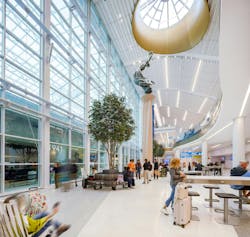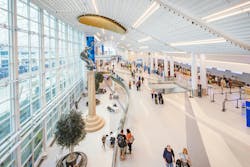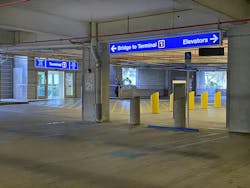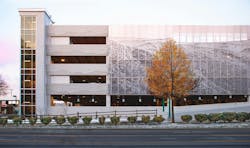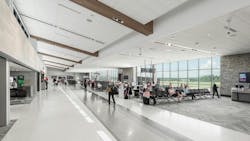Designing Tomorrow’s Gateways
Five Things You'll Learn from this Article
-
How leading airports are using amenities and local concessions to turn terminal time into higher satisfaction and higher spending—and why refresh cycles matter more than ever.
-
Why expanding capacity before renovating existing spaces is the new rule of airport resilience, and how smart phasing protects throughput during long-term construction.
-
How airports are designing flexible, future-proof security checkpoints and adding critical infrastructure redundancy to minimize operational risk and avoid catastrophic single-point failures.
-
Why parking has become both a customer-experience asset and the most powerful non-aeronautical revenue engine, and how airports are rethinking lighting, wayfinding, and premium tiers.
-
What CLT, AVL, and FLL reveal about building terminals that balance passenger expectations, operational continuity, and long-term revenue performance—without shutting down or sacrificing service.

Charlotte Douglas International Airport offers another example with its $600 million terminal lobby expansion. The project doubled the public space to alleviate congestion and introduced a dramatic canopy that elevates the passenger experience at the curbside—protecting and enhancing the pick-up and drop-off experience.
Airports today stand at a crossroads. No longer defined solely as transit points, they are complex ecosystems where every decision—whether about concessions, security, infrastructure, or parking—shapes not only the passenger journey but also the first and last impression of the community they serve. Post-pandemic travel shifts, heightened security mandates, and the evolving landscape of airline competition have left airport leaders managing more variables than ever.
Despite the turbulence, opportunity abounds. By focusing on four core solutions—enhancing passenger experience, designing for capacity and operational continuity, securing infrastructure redundancy, and optimizing parking—airports can transform disruption into long-term advantage. These strategies, informed by lessons across U.S. airports, balance operational needs with traveler expectations, ensuring facilities remain both community gateways and sustainable business enterprises. As airports reinforce their role as community gateways, the first step is reimagining how amenities can turn time spent in terminals into moments of comfort, connection, and commerce.
Solution 1: Enhancing Passenger Experience Through Amenities
In today’s airports, the passenger experience is the overall impression of quality, comfort, and value that the facility delivers. As leisure travel has surged since COVID-19, airports have seen greater demand for amenities that offer comfort, local character, and a sense of discovery. At the same time, business travelers still expect speed, predictability, and premium options. Meeting the needs of both groups requires a deliberate balance.
One proven strategy is blending nationally recognizable brands with local concessions that reflect the surrounding culture. While travelers may look for the familiarity of a Starbucks or Chick-fil-A, they are equally drawn to distinctive local offerings that create a sense of place. Airports that successfully curate this mix both encourage spending and reinforce their role as civic ambassadors.
Equally critical are diverse seating and amenities that serve different traveler profiles. Business travelers may seek quiet areas with power outlets, while families need larger, more flexible spaces where children can reset between flights.
Increasingly, the growth of airport lounges, airline, credit-card affiliated, and “pay for the day” lounges is now a core amenity for business travelers, frequent flyers, and more families who are looking for upgraded facilities and premium services.
Public restroom designs reflect this trend as well, with finishes that emulate the appearance and comfort of high-end hospitality spaces while being engineered for extreme durability.
After clearing security, passenger anxiety typically drops, and travelers are ready to engage with their environment. Locating concessions and retail in this zone captures attention while easing stress. It is important to note that both concessions and amenities (lounges, waiting areas) are refreshed on a five-to-10-year cycle to avoid obsolescence and keep pace with shifting demographics and travel needs. Yet even the most carefully curated amenities lose value if construction and growth disrupt the journey—making continuous operational continuity and passenger trust the next essential piece of the puzzle.
Asheville Regional Airport’s recent terminal expansion embraced local culture, resulting in a facility that distinctly reflects western North Carolina. The new concourse incorporates natural materials like wood and stone, mountain-inspired architectural lines, and artistic metalwork, all bathed in natural light with panoramic views. The airport now features a blend of local and national dining options, expanded restrooms modeled for both comfort and durability, and larger seating areas that offer a greater variety of seating choices shaped by traveler feedback. This approach delivers a memorable, regionally authentic experience that has increased passenger satisfaction and fostered a deeper connection between the airport and its community.
Charlotte Douglas International Airport offers another example with its $600 million terminal lobby expansion. The project doubled the public space to alleviate congestion and introduced a dramatic canopy that elevates the passenger experience at the curbside—protecting and enhancing the pick-up and drop-off experience. Key gathering spaces, including a central courtyard anchored by the Queen Charlotte statue, serve as intuitive “meet-me-at” landmarks that reflect the city’s character and provide welcoming meeting points for travelers.
Enhanced seating, a mix of local and national concessions, and integrated public art have contributed to higher comfort and satisfaction levels, transforming the airport into a true community gateway.
Solution 2: Designing for Capacity and Operational Continuity
Unlike most building types, airports cannot shut down during construction. Modernization, expansion, and renovation must occur while planes keep flying and passengers keep moving. Growth continues with larger aircraft, new routes, and shifting schedules—all of which can increase peak-hour demand without adding a single new flight or seat into the system. Maintaining ongoing operations requires not just clever architecture but also careful choreography of phasing, passenger flows, and communications.
The first rule: expand before you contract. By creating new capacity—such as additional restrooms or expanded concourse seating—before closing existing facilities, airports maintain service levels and prevent passenger frustration. This approach ensures that critical amenities remain available even as older spaces are taken offline.
Transparency is another tool of opportunity. Instead of walling off construction zones entirely, some airports provide sightlines into projects in progress. Passengers who can see progress unfolding are more forgiving of temporary inconveniences. Combined with clear “pardon our dust” communications, visible construction fosters goodwill and builds anticipation.
Wayfinding is equally crucial. Renovation often disrupts intuitive flows, creating detours that disorient passengers—especially infrequent travelers. Investing in clear, intuitive signage and routing design reduces stress and prevents the sense of being lost in a maze.
Airports that succeed in this balancing act demonstrate that resilience is not just about keeping operations running—it’s about maintaining trust with passengers during times of disruption. Beyond construction challenges, resilience also means safeguarding the systems and checkpoints that keep people and planes moving safely, no matter the circumstance.
This balancing act—maintaining service and trust while modernizing for the future—is one of the greatest airport challenges, requiring constant trade-offs between immediate needs and long-term goals.
The multi-phase expansion at Charlotte Douglas International Airport demonstrates the importance of carefully choreographed construction. By opening new public spaces, ticketing areas, and security checkpoints before closing older ones, the airport maintained full operations even while doubling its lobby size. Temporary detours were supported by clear, intuitive signage, and the construction process prioritized transparency so travelers could see progress and prepare for changes in circulation. This phased approach ensured critical amenities were always available and passenger throughput remained high, even during a prolonged period of construction and transformation.
Solution 3: Security and Infrastructure Redundancy
Security has always defined the airport experience. While passenger and baggage screening are now routine, new mandates—such as 100% employee screening—are reshaping terminal design in significant ways. Employee screening is an example of ongoing regulatory changes, but not the primary driver; it illustrates how airports must adapt flexibly to shifting rules. These unfunded requirements strain budgets, consume valuable real estate, and demand operational adjustments.
The solution lies in separating employee checkpoints from passenger flows to prevent bottlenecks, while also designing flexibility into security areas. By surrounding checkpoints with “soft” space, such as offices or storage areas that can be relocated more easily than restrooms or elevators, airports can expand capacity when new regulations arise.
Infrastructure redundancy is equally vital. A single point of failure—whether an IT outage or a utility disruption, or failure in vertical circulation infrastructure such as escalators and elevators —can cascade into mass cancellations, overcrowded terminals, and damaged reputations. Forward-thinking airports are investing in redundant electrical feeds, backup IT hubs, and layered communication systems that allow operations to continue even during crises.
Aging infrastructure means redundancy is more important than ever, as older systems and equipment are at greater risk of failure and must remain reliable for extended periods due to the difficulty of making upgrades in active terminals.
These investments often go unnoticed during day-to-day operations, but in moments of unanticipated disruption, they prevent chaos. Resilience, in this sense, is about designing systems that passengers never realize they rely upon—until they need them most. Just as invisible systems ensure stability inside the terminal, the journey truly begins and ends outside its walls—where parking serves as both a passenger’s first impression and the airport’s most reliable revenue stream.
Charlotte Douglas International Airport’s expansions went beyond aesthetics and convenience to prioritize operational security and reliability. The airport added a new energy plant providing redundant power and mechanical systems, safeguarding against utility outages. Security checkpoints were designed with flexible spaces nearby, allowing rapid adaptation to regulatory changes or new technology. These upgrades ensured that even during disruptions, critical airport functions and passenger safety were preserved. Asheville Regional Airport’s modernization similarly introduced upgraded baggage systems and utility plants, reinforcing the stability of everyday operations and the ability to manage unexpected events.
Solution 4: Parking Optimization as Experience and Revenue Tool
While the previous solutions focus on the terminal, parking stands apart as a crucial, connected element—often the very first and last touchpoint for travelers. In addition, parking is the single largest non-aeronautical revenue source for most airports. Optimizing it is not just about capacity—it’s about designing experiences for different traveler profiles while capturing essential revenue.
A well-designed parking strategy offers multiple products: economy lots for vacationing families, valet for executives, mid-tier options for regular business travelers, and increasingly, digital reservation systems for tech-savvy passengers. Each product tier aligns with a specific traveler profile, reinforcing the airport’s role as both service provider and business operator.
Safety and convenience are non-negotiable. Modern garages incorporate enhanced lighting, higher ceilings for openness, and natural daylighting to reduce the sense of confinement. Wayfinding tools—from bold color-coded levels to AI-driven red/green occupancy lights—simplify navigation and reduce stress. Integrating real-time space availability at entrances further minimizes the frustration of circling endlessly for a spot. Airport parking structures often dwarf their urban counterparts, making clear wayfinding and intuitive navigation essential for both frequent users and first-time travelers.
Beyond convenience, parking is an opportunity for brand reinforcement. Services such as car detailing, electric vehicle charging, and covered pedestrian connectors elevate the passenger experience while generating ancillary revenue. By treating parking as the beginning of the journey, airports set a positive tone that carries through to the terminal. Taken together, these strategies highlight a simple truth: resilient, adaptable design is as much about creating satisfied passengers as it is about strengthening the airport’s long-term business model.
At Asheville Regional Airport, parking was modernized to support a variety of traveler needs—from economy options for families to premium, technology-enabled products. Features such as open, well-lit garages, EV charging stations, and covered walkways prioritize convenience and safety. Real-time availability updates and efficient shuttle service ensure parking complements the overall passenger experience and remains a robust source of airport revenue.
Charlotte Douglas International Airport maintains major parking facilities connected to terminals via pedestrian bridges and emphasizes user-friendly navigation with effective signage. During recent expansions, the airport’s phasing plan kept parking accessible at all times, providing continuity for both business and leisure travelers while strengthening the airport’s position as an efficient gateway for the region.
Fort Lauderdale–Hollywood International Airport has recently prioritized improving the parking experience as a strategic element of passenger satisfaction and airport revenue. Comprehensive upgrades to signage, wayfinding, and garage layout have made parking navigation more intuitive, reducing frustration and helping travelers easily locate available spaces and return to vehicles after a trip. Enhancements include new illuminated row numbering systems, clearer directional signs, and consistent messaging throughout parking facilities. While designed to elevate customer experience and operational efficiency, these initiatives also increase parking utilization and reinforce its role as a reliable, high-value source of non-aeronautical revenue for the airport.
Key Takeaways
- Flexibility matters. Building in expansion space and designing for adaptability prevents costly disruptions tomorrow.
- Passenger experience is revenue. Investments in restrooms, concessions, and seating have measurable returns in both satisfaction and spending.
- Resilience extends beyond security. Utilities, IT systems, and staffing strategies are just as critical to long-term viability. Parking is a strategy, not an afterthought. As the first impression and largest revenue driver, it deserves the same design focus as concourses and terminals.
Airports occupy a unique role in public life: they are the first and last impression of a community for millions of travelers. In an era of shifting demographics, evolving security mandates, and growing competition, success requires more than keeping planes on time. It calls for foresight, collaboration, and solutions that unite operational resilience with passenger-centric design. By focusing on four key solutions—enhancing amenities, ensuring operational continuity, strengthening infrastructure redundancy, and optimizing parking—airport leaders can transform their facilities from mere transit points into civic assets, economic engines, and enduring gateways to the communities they serve.
